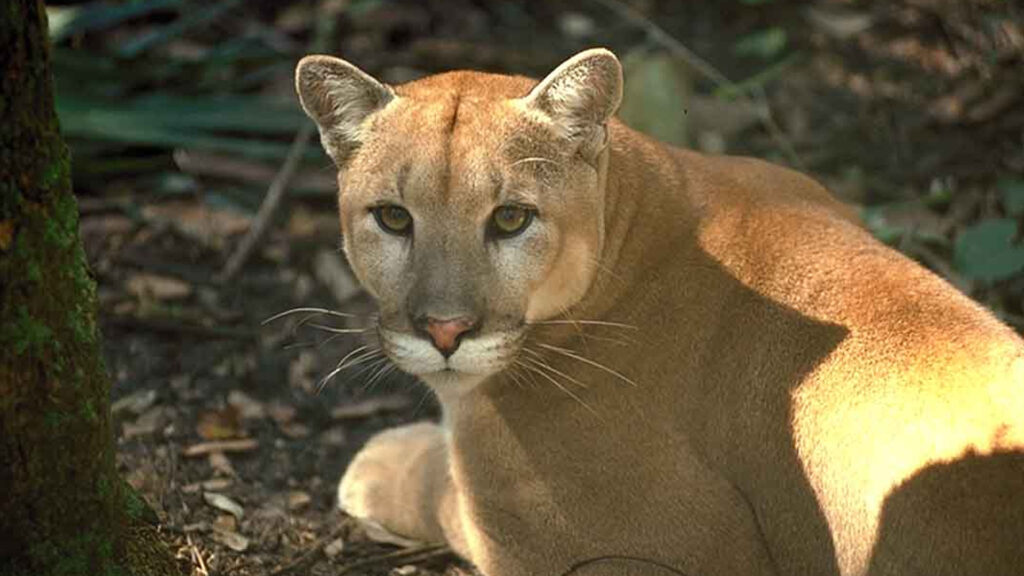By Mia McCormick, Environment Florida
The sleek, stealthy Florida panther is a throwback to the Sunshine State’s roots, when live oak hammock thick with hanging mosses stood on islands amid impenetrable, brackish swamps. Tawny panthers rested in trees by day, blending into blowing grasses on vast areas of dry prairie or silently melding with the muddy banks of tidal estuaries when on the hunt.
In 1982, Florida’s schoolchildren chose the animal as the state mascot, perhaps with optimism. By then the panthers were on the Endangered Species List and their population had shrunk to about 50 in southwest Florida. Great efforts were made to help the big cats recover, and at their peak there may have been more than 250 roaming southwest Florida. But once again the panther population is on the precipice of extinction, with only about 150 alive.
While genetic issues and a troubling neurological disease are weakening the species, data proves vehicles pose the biggest threat to panthers. Large-scale developments, such as the proposed 10,000-home Kingston project in Lee County, adjacent to Corkscrew Swamp Audubon Sanctuary, continually multiply traffic on roads that wind through primary panther habitats.

The human population surrounding panther habitat has more than doubled since the ‘80s, from 10.5 million to 22.6 million. The panthers’ access across its historical range for hunting and mating is now diced into small parcels by pavement, fences and tracts of condo buildings.
On the 50th anniversary of the bipartisan Endangered Species Act, our representatives in Congress must act on the Recovering America’s Wildlife Act (RAWA). That legislation will provide states with the funding necessary to implement projects on their wildlife action plans, helping animals before they reach critically endangered status.
The bill is a response to the alarming pace of wildlife decline across the country. In Florida, RAWA dollars might mean purchasing more land critical to wildlife corridors or adding more wildlife crossings for major thoroughfares.
On Feb. 2, U.S. Sen. Marco Rubio co-sponsored the measure, signaling his understanding that Florida’s wildlife needs help to survive.
Wildlife crossings over and under the region’s teeming highways are crucial. These structures are effective at reducing animal mortality and enabling access to habitats. Dozens of wildlife crossings dot Florida already but there aren’t enough to keep up with the sprinting pace of human population growth and development.
The state has set aside more than 4 million acres of land for wildlife but there’s no disputing that the highways bisecting these tracts are death traps for animals. Wildlife officials maintain a map of Florida with hundreds of blue dots that indicate where a native panther was found dead. Straight lines of blue dots trace the highways through panther habitat.

Floridians need to build a more positive future for panthers again, by providing them safe access to their traditional range without deadly vehicle collisions.
So far this year, vehicles killed three panthers on roads in Hendry County, and one in Lee County, just north of the Florida Panther National Wildlife Refuge. The death toll for panthers has been about two dozen per year. When only 13 were killed in 2023, wildlife biologists thought it could mean that the population was already dangerously low.
If funding will promote the species’ survival, we are obligated to act. The panther is the perfect subject for the direct action that RAWA promises. Hopefully Sen. Rubio can convince the U.S. Senate and the rest of Florida’s congressional contingent to get behind the bill.
Pass the Recovering America’s Wildlife Act, because we don’t have the luxury of waiting any longer — we need our leaders to make wildlife a priority now.
Mia McCormick is an advocate with Environment Florida, a policy and action group with one mission: to build a healthier, greener Sunshine State.
If you are interested in submitting an opinion piece to The Invading Sea, email Editor Nathan Crabbe at ncrabbe@fau.edu. Sign up for The Invading Sea newsletter by visiting here.




My work experience in the Fakahatchee Strand SP (Collier County) educated me close up how amazing the Florida panther is and what entrepid felines they are. Pumas are epic apex cats, the last eastern puma hold-out and have survived insurmontable odds in Florida. We need to purchase additional habitat in a proactive way for all native Florida wildlife and aquifer storage to protect ground water from contaminants poisoning our springs. Land bridge crossings must be installed, like Californias 101 for their pumas. With the millioms of miles of highways, roads in the US we owe nature an off ramp. New hwys are being built on I-4. The 417 near Haines City is being completed in a critcal corridor area for cats and bears. The I-95 and US1 interchange at Destination Ormond deveiopment that’s coming to Volusia/Flagler counties.is a prime location for overpass installation. RAWA and DOT funds needs to be implemented and turned into safe havens for animals negotiating roads and rearing young in designated habitat expansions. Congress needs leadership and education about commiting funding now not later. If only congress wakes up to our dark global forecast that’s looming.